LAKELAND – Detailed subsurface evaluations are set to begin this winter for a carbon storage hub expected to be built in the Cold Lake area within the next decade.
The Carbon Sequestration Evaluation Agreement between the Alberta Government and Pathways Alliance is the latest step in assessing the suitability of a Carbon Capture and Storage (CCS) system in northeast Alberta.
“This agreement marks another significant milestone on the road to finalizing plans for our proposed CCS project in northeastern Alberta and achieving our goal of reaching net zero emissions by 2050 to help Canada meet its climate commitments,” said Kendall Dilling, President of the Pathways Alliance.
The agreement enables the Pathways Alliance to immediately start a detailed evaluation of its proposed geological storage hub which would be one of the world’s largest CCS projects.
Launched in 2021, Pathways Alliance is a collaboration between Canadian Natural, Cenovus Energy, ConocoPhillips Canada, Imperial, MEG Energy and Suncor Energy, which together operate approximately 95 per cent of Canada’s oil sands production.
Collecting data
Assessing the geological characteristics and properties deep underground will help determine the most suitable location for CO2 storage.
“The evaluation of the storage hub is specific to the underground characteristics of the area,” Dilling told Lakeland This Week.
“We will be conducting tests on wells in the area to inform our engineering and design plans for the hub, as well as regulatory applications. We are planning testing at approximately four sites, with the potential to test more should further examination be required."
When it comes to surface level work and site surveying, Dilling said it isn’t a part of the hub evaluation, but it is an important part of the broad environmental program for this project.
“Last year we completed a full year’s worth of environmental field data collection, and we’ll do another season’s collection this year and have our regulatory applications for this project ready to submit by the fall.”
The applications and data collected will be submitted to the Alberta Energy Regulator for review and approval.
Findings from the upcoming tests and evaluations will also help with creating field development plans to support the final application for a storage agreement and any other regulatory approvals needed along the way.
“We appreciate the comprehensive and collaborative efforts of the Government of Alberta to manage the growth of carbon capture and storage strategically and responsibly,” he said.
“CCS has been globally recognized as one of the most effective means of reducing industrial greenhouse gas emissions, and Alberta’s geology makes this one of the most ideally suited places in the world to safely inject and permanently store CO2.”
The project is critical to achieving Pathways Alliance’s plan to reduce CO2 emissions from its member companies’ oil sands operations by 22 million tonnes by 2030 and enabling the goal of net zero by 2050.
“With this agreement in place, we can continue to progress this ambitious project that will help position Canada as one of the world’s most advanced nations in decarbonizing its energy production,” Dilling added.
Ultimately, the proposed carbon storage hub in Cold Lake would be connected to a transportation line that would initially gather captured CO2 from an anticipated 14 oil sands facilities in the Fort McMurray, Christina Lake and the Cold Lake region.
The long-term plan is to grow the transportation network to include over 20 oil sands facilities, and to accommodate other industries in the region interested in CCS.
However, Pathways Alliance does point out that statements on the proposed carbon storage hub are “forward-looking” and are based on current expectations, estimates, projections and assumptions at the time the statements are made.
“Forward-looking statements are not guarantees of future performance and involve a number of risks and uncertainties, some that are similar to other oil and gas companies and some that are unique to the companies,” states the organization.
“Actual results may differ materially from those expressed or implied by its forward-looking statements and readers are cautioned not to place undue reliance on them.”
Engagement is ongoing with local stakeholders and First Nation and Métis communities along the proposed CO2 transportation line and storage network.
Canadians can learn more about Pathways Alliance’s plan and its collaboration to develop and deploy technologies to reduce emissions by visiting https://pathwaysalliance.ca.
RELATED STORY: Cold Lake area proposed as site for underground carbon capturing



